Tap away from to move;
Pinch/Zoom to contract/expand
( X )PrevNext

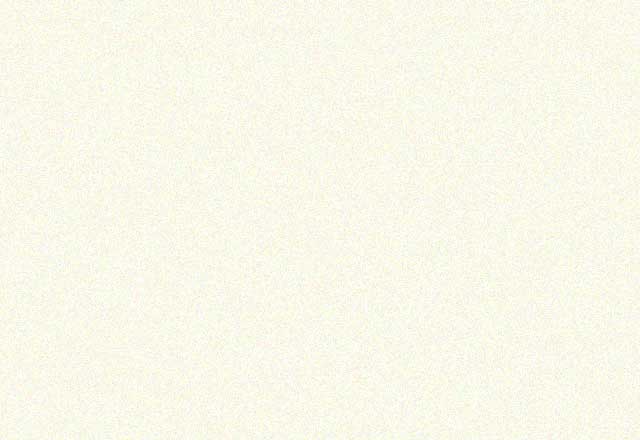
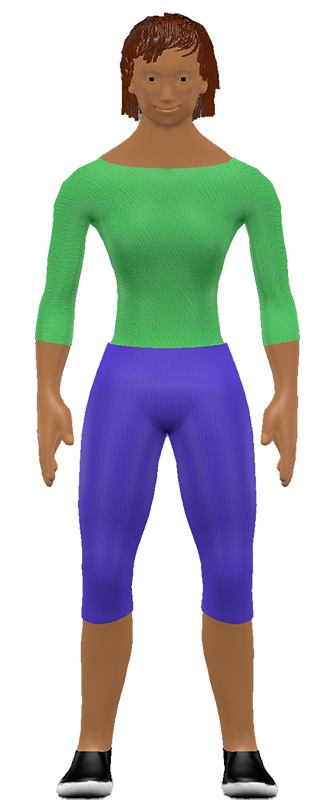
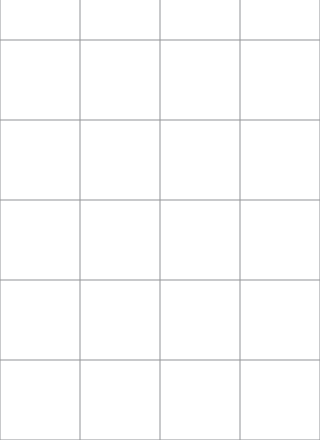


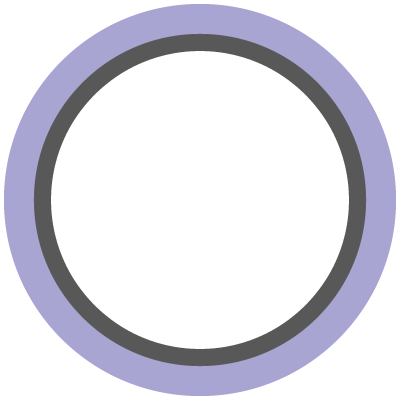





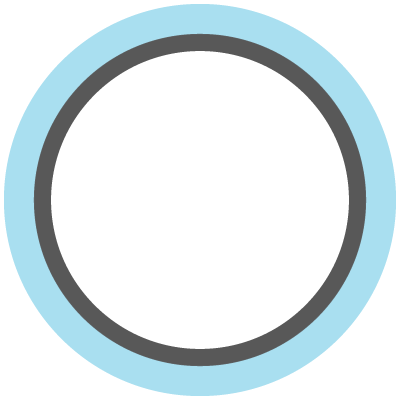


Scan Your Body / Relax Your Focus
Text description of the energy.
Each direction you face while doing anything imparts a different energy to your experience and its outcome. This is called Feng Shui.
The current direction is:
| Direction | |
| I Ching Trigram | 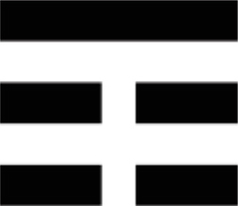 |
| Trigram Name | |
| Trigram Energy |
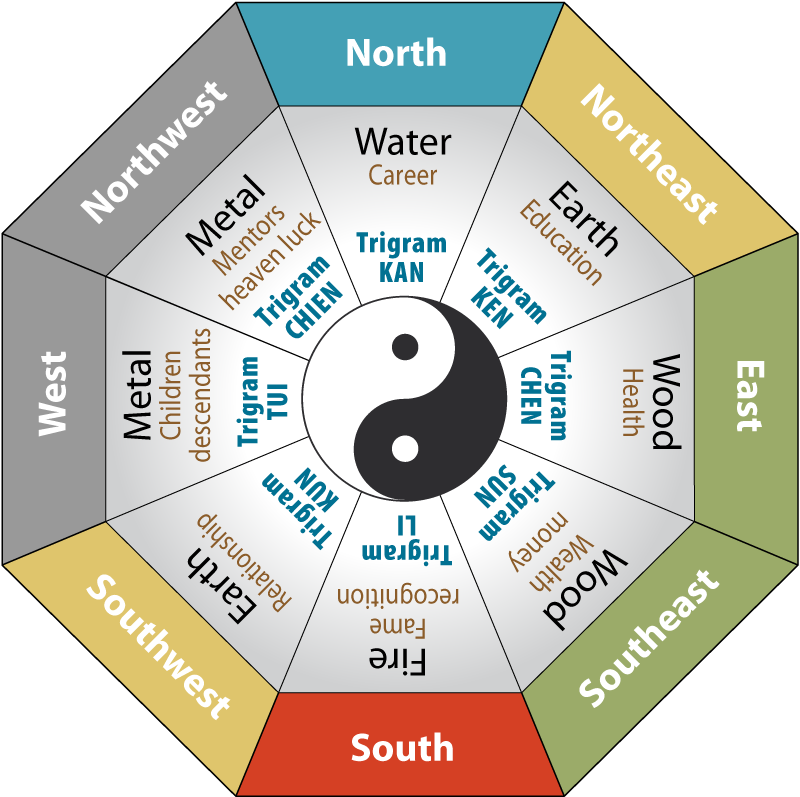

PJCC Group Exercise Studio, Mondays 8am-9am

PJCC Group Exercise Studio, Wednesdays 8a-9a
Here is a random tai chi tip.
Here is a random tai chi video for you to enjoy.
It is sometimes helpful to align your chakras before starting tai chi. It makes your tai chi better, because you are more aligned with the Universe.
The complete silkreeling set takes 1 hour and has many exercises per joint. This shorter way to do it has only one exercise per joint.
Standing meditation is very important for aligning the body posture and preparing for Tai Chi movement.
The video above shows how to get into this posture, which is the posture that starts the tai chi form.
You can stand in this posture for as long as you want.
The video above shows a way to relax tight shoulders and neck.
In Tai Chi, the feet, legs, and waist move in precise ways. The rear leg is rotated half a corner of a square (45 degrees). The front toes point directly forward.
Some people like to keep all finger movements flowing, but some keep the fingers and thumbs together. The 'hook' hand has all fingertips touching with the middle finger slightly out. When punching, the right fist rotates down at the end of the punch and the left elbow strikes backward with equal intensity to the right fist.
When the hands and arms or feet and legs move, the center moves. This makes for whole-body motion. Tai Chi movement also includes sinking down, slightly spiraling movements, and coordinated opening and closing movements of all the joints.
PART I
PART II
PART III
PART I
PART II
PART III
Contents:

| NAME OF MINI-EXERCISE | INSTRUCTIONS |
|---|---|
| Move the Water in the Shoulder Wells (Good for keeping chi healthy after age 50.) |
|
| Empty Liver Anger from the Armpits (Good for reducing relationship frustration.) |
|
| Empty Spleen Stagnation from Hips (Kua) |
|
| Roll Fingertips of Tiger Claw Hands on Table (Good for overall health & increasing intelligence.) |
|
| Cool the Heart Fire with Kidney Water (Good for calming yourself down.) |
|
| Help Digest a Big Meal |
|
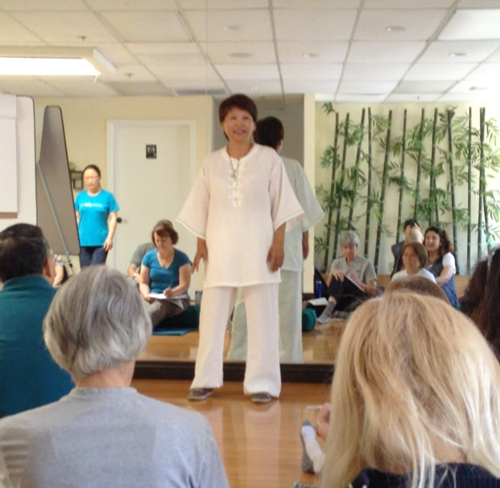
Written by Zen Buddhist Patriarch Da Mo (Bodhidharma) after meditation in front of a cliff wall for 9 consecutive years in 500 AD and thinking about how to get the meditators of his day in shape after focusing only on their Minds (Chi), not their Bodies (Blood, or Liver fluid).
Professor Qu Limin is the source of most of these notes. She gave a workshop June 25-26 in San Jose, CA and Sunnyvale, CA through Tai Chi Master Tony Wong's support.
Why is the YJJ the only Classic Text of QiGong? Because it starts 50% Yang and 50% Yin, leading with the thumb side of the hand, not the back or front of the hand.
| Notes | Image |
|---|---|
TCM Basic Acu-PointsThe Most Yang Point (Ba Gua, "Bah-Guey") is where 100 yang lines (all yang paths of the body) meet. There is another such point, at the big bone protruding at the vertebra at the base of the neck. The Bubbling Well points are where the Human Essence begins to emerge from the Earth's energy. The Most Yin Point (Hui Yin, Perineum, the point between anus and genitals) is the starting and ending point for all energy in all QiGong exercises, says Professor Limin Qu. The Shoulder Well points (where the Clavicle is felt between the shoulder muscles) on either side is the most important Health Maintenance Point in gigong. The basic exercise for "moving the stuck (tight) energy in the Shoulder Wells" is slow shoulder rotation exercise. On each side of the body, the Bubbling Well is where our Personal Energy starts, and the Shoulder Well is the peak of our Personal Energy. Professor Qu Limin says, "If you align the Bubbling Well Points with the Shoulder Well Points of both sides, and the Most Yin Point with the Most Yang Point while standing, this is better than doing the exercise form 100 times." |
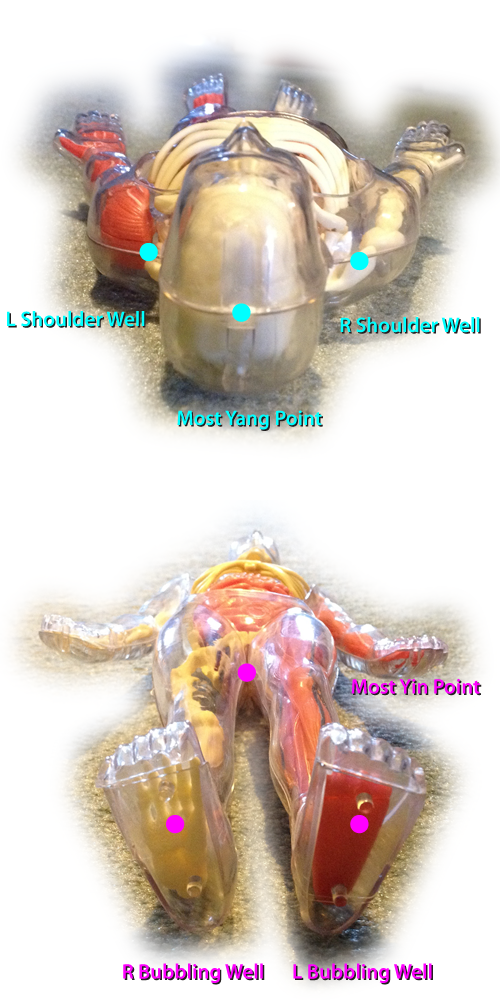 |
TCM Main Channels (Meridians)The Governor Meridian runs along the skin from the Perineum up the spine, over the head through the Most Yang Point, and down to the hard palate just behind the front teeth. The Conception Meridian runs from the Perineum along the front of the body to the tip of the tongue. When the tongue curls slightly at the tip and touches behind the front upper teeth, the circuit is completed and Qi and Blood flow well. When talking the circuit is broken. Hold a slight tension in the Perineum to keep the essences from "dripping out" the bottom of the loop. The Qi and Blood can circulate in either direction, and to force it to change in either direction is thought to be unnatural. This energy loop is called the Microcosmic Orbit, because Qi and Blood are thought to be like the Sun and Moon moving relative to the earth, and the Human Body is like a universe in miniature. This is why the 9 Palaces Map is also used for Feng Shui, enabling practitioners to adjust living spaces according to the same universal principles which govern the human body and its organs. |
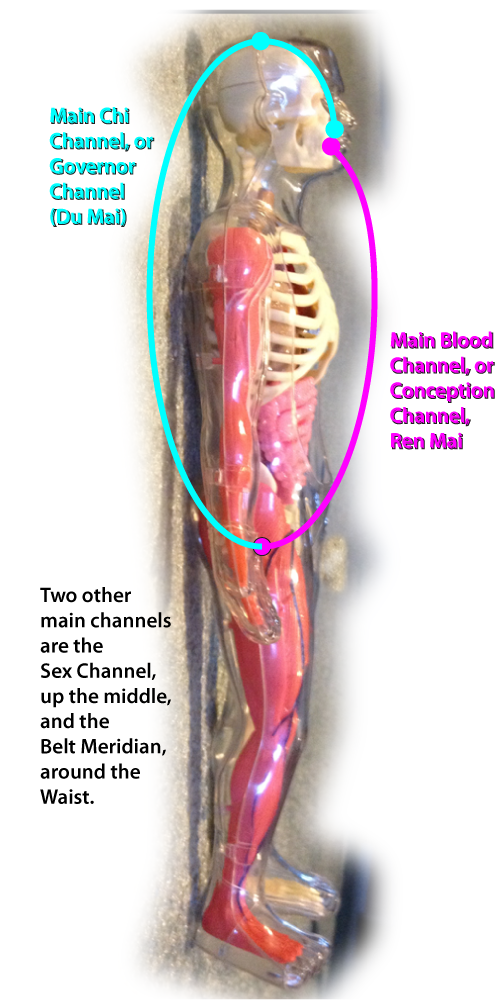 |
TCM Chi Flow Side ViewIn reverse direction, cooling occurs. This can be done naturally, as when the body gets ready for sleep, or deliberately, as a meditative exercise. |
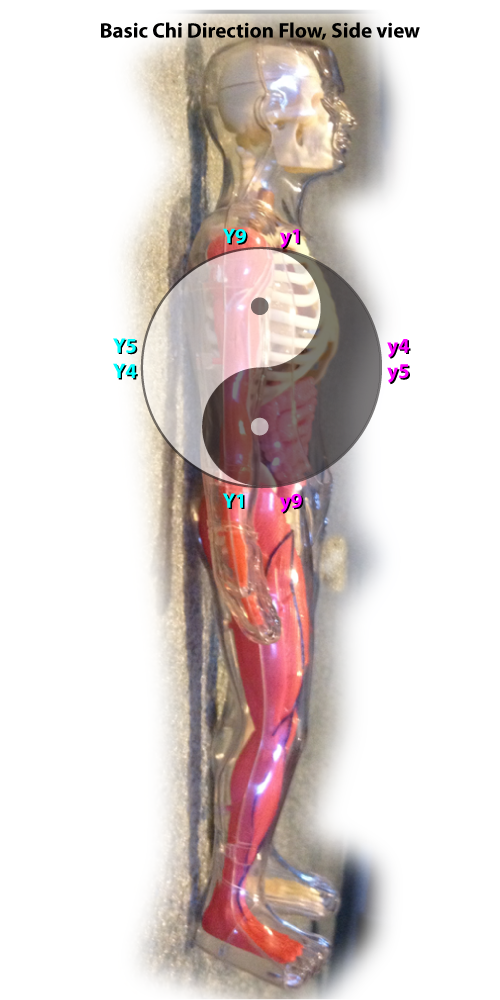 |
TCM Eight Vessels to EmptyEnergy stuck in these vessels (4 left, 4 right) cause health problems. Actively release them before and while doing the Tai Chi or QiGong forms. |
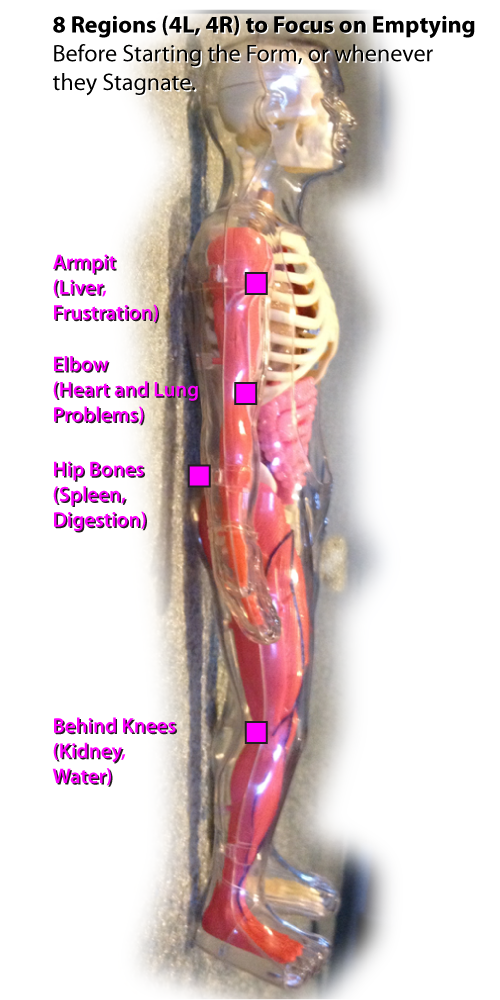 |
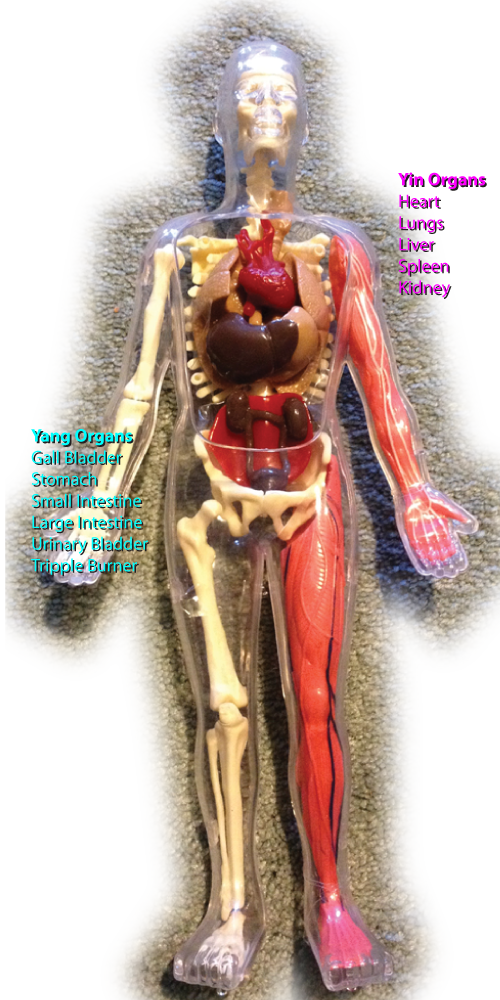
Yin Organs are Female, protected indoors (Rib Cage), and collect the money (Nutrients)
Yang Organs are Male, work outdoors (not in rib cage), and are always moving.
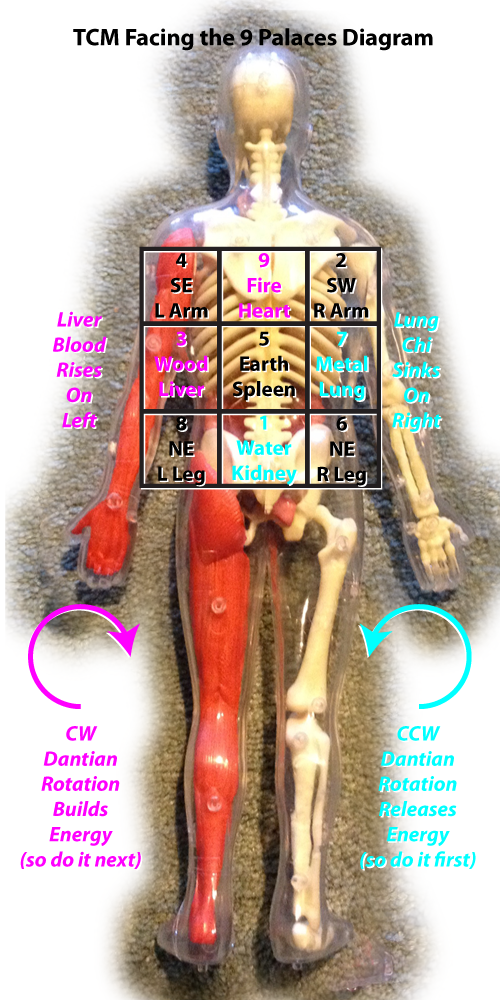
Western European Anatomy studies show the Liver on the Right side of the abdomen under the ribs; Chinese Medicine feels the Liver Blood to be rising on the Left side of the body.
Clockwise DanTian rotations starting from the Water region build energy according to the 5 Element Creation Cycle: Water -> Wood -> Fire -> Earth -> Metal -> Water...
Therefore, Counterclockwise DanTian rotations starting from the Water location (below navel) break down or release energy since you are moving your internal energy with your hands against the 5 Element Creation Cycle: Water -> Metal (Lung) -> Fire (Heart) -> Wood (Liver) -> Water (Kidney or Bladder).
Empty yourself before refilling, of course. When your hands are positioned below your navel and you're starting dantian rotations, go to the right first.
Men are more Qi dominant, so they encourage Yin-Blood-Liver-Left Hand covering the Right Hand when doing dan tian rotations; Woman are more Blood dominant, so they encourage Yang-Qi-Lung-Reft Hand covering the Left Hand when doing dan tian rotations.
Since Blood moves slower than Chi, start your qigong or tai chi form by moving the left leg (Liver-Blood side) first to give it a head start. Then activate the Chi by turning the big toes in toward each other imperceptibly, which opens the lumbar back very slightly. Now your Yin-Yang Chi Engine is ready to go!
Start the form very deliberately, and End the form very deliberately.
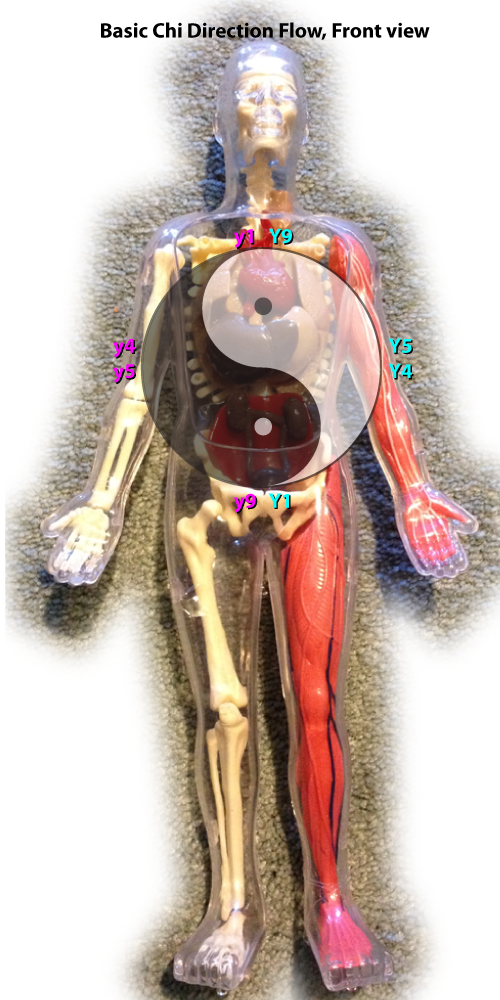
In reverse direction, energy is 'destroyed,' or released.
The maximum potency and minimum space of yang is at Y1, like in a baby boy.
The minium potency and maximum space of yang is at Y9, like an old man.
The most stable yang energy, at Y4, is said to be 4x9=36 year old male, said Dr. Qu Limin.
The male reproductive energy is best at 4x8=32 years, according to the Yellow Emperor's Internal Medicine Classic.
At Y5 (40 years old), the male energy is already deteriorating, says Dr. Qu Limin.
For women, the formula is similar, but the best yin energy is at Y4, (? years old). The Yellow Emperor said women reproduce best at 4x7=28 years old.
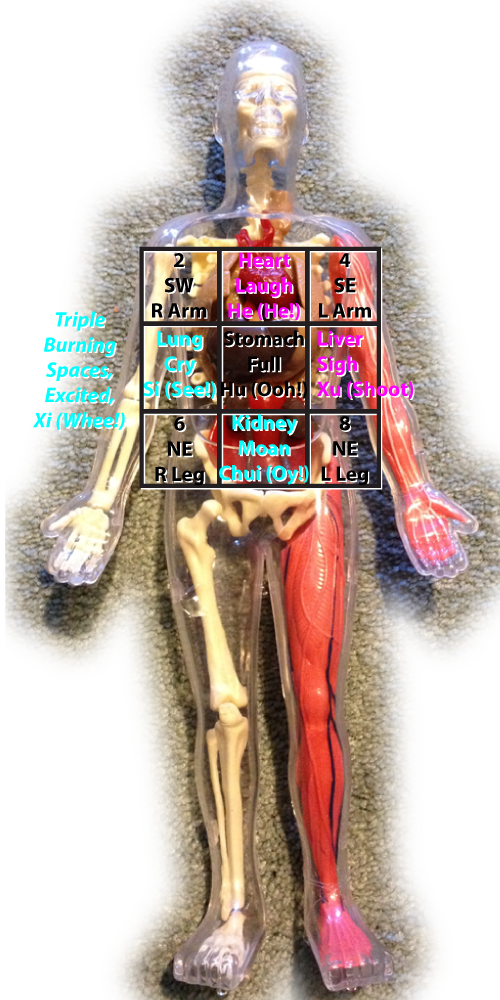
Form your lips and throat into the usual shape to say the sound out loud, but make the sound only in your head to keep the energy inside.
Make the internal sound and do the corresponding exercise the number of times indicated for that organ's position in the 9 Palaces Table.
The Heart Sound (He) can be made with decreasing pitch in your inner voice as you cycle energy Down, Forward, Up, Back, and Down to "pour Kidney water over the Heart fire to cool it."
Tap away from to move;
Pinch/Zoom to contract/expand
( X )PrevNext















Scan Your Body / Relax Your Focus
Text description of the energy.
We align the chakras by paying attention to each one. This helps you do tai chi better, because you're more connected to the whole Universe.